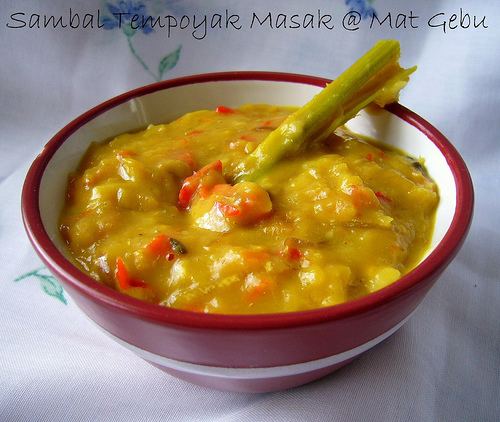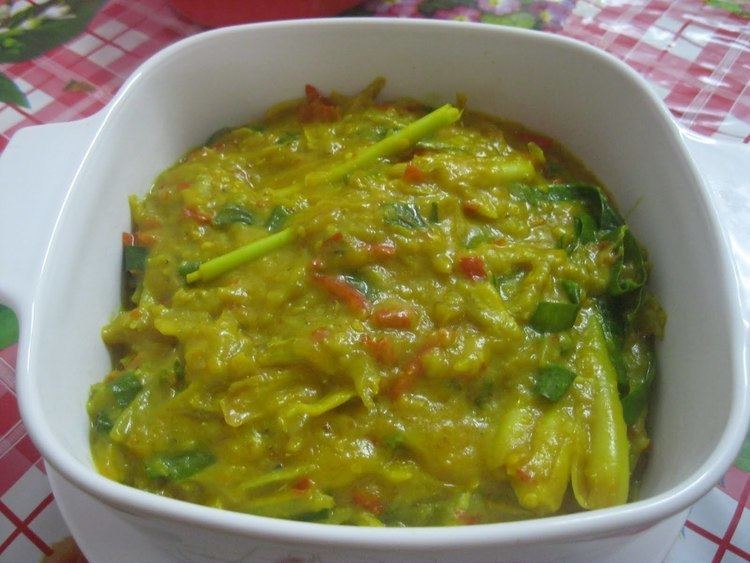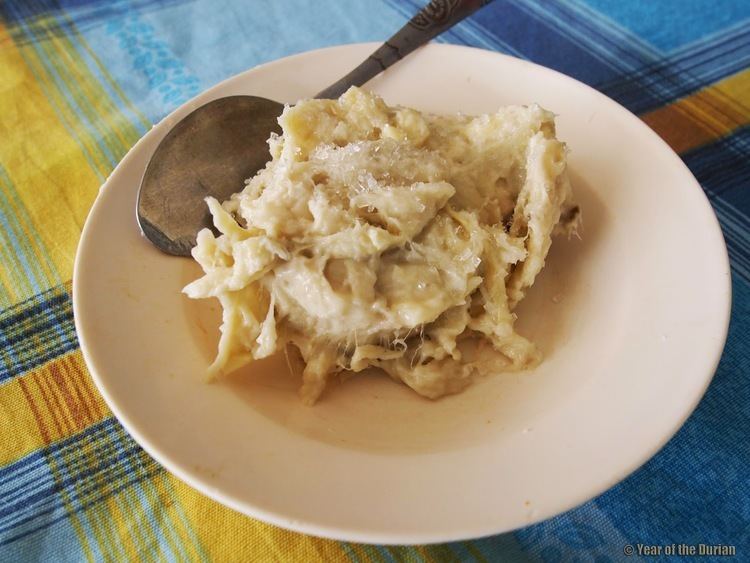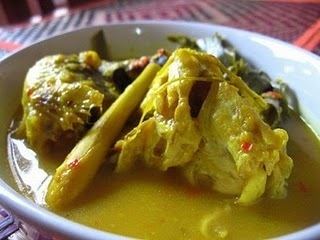Created by Ethnic Malays | Type Condiment Main ingredient Durio zibethinus | |
 | ||
Similar Gulai, Durio zibethinus, Asam pedas, Ulam, Budu | ||
Tempoyak (Jawi: تمڤويق), asam durian or pekasam is a Malay condiment made from fermented durian. It is usually consumed by the ethnic Malays in Indonesia and Malaysia. Tempoyak is made by taking the flesh of durian and mixing it with some salt and kept in room temperature for three or five days for fermentation. Tempoyaks are usually made during the durian season, when the abundance of durian and excess production are made into fermented tempoyak.
Contents

Tempoyak is not normally consumed solely, it is usually eaten as condiment or as an ingredient for cooking; such as cooked with coconut milk curry as gulai tempoyak ikan patin (pangasius fish tempoyak curry), or mixed with spicy chili pepper as sambal tempoyak.

Sambal tempoyak sambal 025
Fermentation

In Malay archipelago, fermented durian is known in many names. It is commonly known as "tempoyak" in Malay Peninsula, Borneo, and Southern Sumatra region (South Sumatra, Jambi, Bengkulu and Lampung provinces). It is known as pekasam in Aceh and asam durian in Minangkabau region of West Sumatra. The word asam which translate to "sour" describes its fermentation process.

Tempoyak is made by taking the flesh of durian and mixed with salt and kept in room temperature and left for fermentation process for three or five days. As a fermented food, tempoyak-making process involves a number of lactic acid producing microorganisms, or more commonly known as lactic acid bacteria. Isolated lactic acid bacteria which form colonies in fermented durian are Lactobacillus casei and Lactobacillus rhamnosus sub sp fersantum. These lactic acid bacterias inhibit the growth of harmful decomposing bacterias, such as Escheria coli, which in turn preserves the durian flesh. Besides its functions as food preservative, fermented tempoyak also serves as a natural food flavoring. The addition of tempoyak into chili paste and curry, will add distinct aroma and savoury flavour to the dish.
History

Just like many fermented food products in the region (e.g. belacan, tempeh, oncom, tapai), tempoyak was probably discovered unintentionally; from the excessive unconsumed durian and thus left fermented, during the abundance of durian season in the region.
Tempoyak is mentioned in Hikayat Abdullah as a staple food for the people of Terengganu. When Abdullah Abdul Kadir visit Terengganu around the year 1836, he said that one of the favorite food of the local resident is Tempoyak. Based on Hikayat Abdullah, tempoyak is a food special to the ethnic Malays, which is the Malay in Malaysia and Indonesia which is in Sumatera and Kalimantan.
Indonesia
In Indonesia, tempoyak is especially popular in Palembang, and also in other cities in Sumatera such as Jambi, Bengkulu, Lampung and also Pontianak in Kalimantan.
In Palembang the dish tempoyak ikan patin (Pangasius catfish in tempoyak sauce) and brengkes (pepes) tempoyak are well known, which is a steamed fermented durian paste in banana leaf container, usually mixed with patin (pangasius fish) as brengkes ikan patin tempoyak. A spicy condiment called sambal tempoyak is made from the mixture of fermented durian, ground belacan (shrimp paste) and chili pepper.
In Lampung, tempoyak is made as sambal seruit tempoyak. Seruit is shredded fried freshwater fishes, such as patin (pangasius), baung (hemibagrus), lais (Kryptopterus), belida (featherback) or mas (carp), mixed with ground chili pepper, tomato, shallot, shrimp paste, lime juice, young unripe mango, salt and tempoyak.
In Pontianak, tempoyak is usually served as spicy condiment, mixed with red chili pepper, fresh shrimp or teri (anchovy) and petai (green stinky bean).
Malaysia
In Malaysia, tempoyak is specifically popular in the state of Pahang and Perak, yet it is also can be found elsewhere, from Kuala Lumpur to Sarawak. In Malaysia, tempoyak is an essential ingredient for gulai tempoyak ikan patin (pangasius fish tempoyak curry). In Sarawak, tempoyak is available in marketplace. It taste sour and salty with a lot of durian nutty flavour, and essential ingredient for cooking soup with tang hoon or glass noodles.
